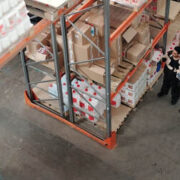Manufacturers need a robust item management solution in their ERP system. A modern ERP solution can help you to manage items and product families and eliminate sales and purchasing errors due to items with slight variations.
Item management is one of the biggest day-to-day headaches for distributors. Especially if you carry products with slight variations in size, style, or other attributes. When it comes to managing items in your ERP system, these small variants result in hundreds or thousands of combinations of unique items. It’s difficult to manage extensive portfolios of products and even more challenging to tell products apart during order entry, picking, or other activities.
How does your distribution business manage costs, pricing, and other details with so many similar products?
Modern ERP solutions, like Acumatica are built to handle the challenges of today’s distributors. For example, Acumatica simplifies item creation by using a combination of attributes and values. It also automates the sales and purchasing processes for product families with flexible options for order entry. Learn more about the tools in Acumatica’s Distribution Edition to help you reduce errors, costs, minimize write-offs, and increase sales.
Download 5 Ways Acumatica Simplifies Item Management for Wholesale
MATRIX ITEMS: Manage Items Effectively Using Attributes
By using matrix items, Acumatica automates and streamlines item creation, sales, and purchasing processes for related products (product families). Items in this matrix start with a master SKU or template. Then, each attribute has options that define the characteristics of the unique inventory item, such as:
- Size or Dimension
- Material or Grade
- Product Composition
- Color or Style
- Manufacturer or Model Year
- Packaging
KITTING & DISASSEMBLY: Stock & Pick Items More Efficiently
 Most distributors utilize kits. Kits are bundles or parts assembled, stocked, and sold together as a group. Sometimes these are preassembled for order fulfillment, other times once the kit is sold, the pieces are picked during the fulfillment process. Many times, non-stock items are assembled into kits including labor, instructions, or manuals but tracking these by their base components. Kitting can help to increase profits and minimize costs but without an effective tracking system, it can cause headaches for your business.
Most distributors utilize kits. Kits are bundles or parts assembled, stocked, and sold together as a group. Sometimes these are preassembled for order fulfillment, other times once the kit is sold, the pieces are picked during the fulfillment process. Many times, non-stock items are assembled into kits including labor, instructions, or manuals but tracking these by their base components. Kitting can help to increase profits and minimize costs but without an effective tracking system, it can cause headaches for your business.
SERIAL AND LOT TRACEABILITY: Manage Recalls & Compliance
Lot tracking and traceability is critical in the distribution industry. You assign identification labels to production runs called “lots,” which can be tracked throughout the supply chain. These may include raw materials, intermediates, or finished goods.
These labels allow companies to scan and store information about the material, including its location in the warehouse, when it was received, who the supplier is and when it was purchased. Industry compliance and regulations mandate that you can track these “lots” to identify materials as they move through the manufacturing process into distribution and sales.
Proper lot tracking and traceability is a best practice in the distribution industry and helps you more accurately track what’s going, where things are at, and in case of a recall, be in compliance.
VARIABLE UNITS OF MEASURE (UOM): Speed Up Your Processes
Converting units of measure can be a huge pain point for manufacturers and distributors. For example, you may purchase something by the case, stock by individual units, and sell it in a different quantity. Distributors may buy larger packages of goods and break them down for resale. Gallons, drums, pallets, bottles, and more. Some distributors use kitting to create larger containers of products for bulk orders. Conversely, they may disassemble larger packages into smaller quantities to create unique SKUs or to fulfill demand when they are out of stock for smaller packages to avoid costly backorders or rush orders from vendors.
EXPIRATION DATES: Manage Expiration Dates and Stock Rotation
 Expiration date management is important for distributors handling perishable food. Tracking these dates is key when fulfilling orders and knowing which items to pick based on dates. This process, called first-expired, first-out, limits risks and costly inventory going bad. By closely managing your expiration dates, you can manage your stock rotation and avoid costly mistakes.
Expiration date management is important for distributors handling perishable food. Tracking these dates is key when fulfilling orders and knowing which items to pick based on dates. This process, called first-expired, first-out, limits risks and costly inventory going bad. By closely managing your expiration dates, you can manage your stock rotation and avoid costly mistakes.Learn more about how Acumatica, a modern ERP solution can help solve some of the common distribution industry pain points. Download 5 Ways Acumatica Simplifies Item Management for Wholesale Distributors and call 440-498-9920 or email sales@parallelsolutions4u.com to discuss your needs with one of our experienced distribution team members.




